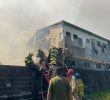He is then directed to the third officer of the BEI who marks an indelible ink on the nail of his forefinger.
After which, the voter will have to go back to the poll clerk again for affixing thumb marks and signature on the EDCVL folder. At the same time, the BEI chair signs the EDCVL, each time a voter has finished part of the vote-casting process.
The entry and exit process for each voter seemed to take more time. At past eleven in the morning, only 100 of the 800 registered voters in the cluster were able to cast their votes.
This means an average of only 25 voters were able to complete the voting process in a span of one hour, contrary to the Commission on Election’s (Comelec) projection of 20 voters in eight to 10 minutes.
At the end of the day an average of only 54 per cent of the total number of registered voters were able to cast their votes in the three clusters of Villa Abrille Elementary School.

A teacher checks the name of a voter in the voter's registration record, which contains forms earlier filled by voters upon registration. At her back, a voter checks her name on the election day computerized voters' list. (davaotoday.com photo by Cheryll D. Fiel)
Of the 892 registered voters in cluster 207, only 55 percent or 492 were able to vote, according to the Comelec records. O f the 867 registered voters in cluster 208 only 57 per cent or 498 were able to vote and of the 976 registered voters in cluster 212, only 50 per cent were able to vote.
The incidence of ballot rejection in the three clusters averages 1.4 percent; eight ballots were rejected in cluster 207, 5 ballots in cluster 208 and 8 ballots in cluster 209.
Lorelie Acopiado was one of eight voters whose ballots were rejected in cluster 207. The oval beside the instruction note above the ballot she filled out was found out to have been shaded.
When asked if the shade had been there, Acopiado said she was not sure.
In cluster 208, the BEI’s marked Aurora Prieto ballot rejected when the machine refused to take it after five attempts. The BEIs cited “ambiguous marks found on the ballot” as the reason indicated in their official minutes.
When checked, it was found out that the voter shaded more than one party list.
Most of the voting had been declared closed at around 7 pm except for those clusters where many voters were still filing outside the polling precinct. This was true to cluster 212 where around 100 voters were still on the line at about 6 pm.
Among the voters, Manuel Calumpag said he had been lining up outside the doors of polling precinct since 1 pm.
Tired and hungry, Calumpag left the line and thought it best to return at 5 pm where he was hoping the line would no longer be too long.
He was mistaken because when he came back he had to wait for another two hours.
Calumpag said he even saw some of his neighbors leave the polling precinct and gave up.
The BEIs at cluster 207 declared the voting closed at around 7:15 pm.
BEI chair Ester Jimenez pressed the function key on the PCOS machine to close the poll. A command then appeared on the screen requiring the BEI to “digitally sign” the transmission file with a BEI signature key. At this point, Jimenez had to go out and seek assistance from the Smartmatic-TIM technician.
But the technician was still busy helping other BEIs in another cluster. The BEI chair was told to just press the “No” button instead. After she did so, the PCOS machine printed election returns of national and local candidates.
As this was happening, it turned out that the BEIs at cluster 208 had the same problem.
They needed the Smartmatic technician, too. But the Smartmatic technician was still servicing the 2nd cluster precinct request. It was almost midnight and the Villa Abrille school had 24 clustered precincts.
Unless the watchers stuck it out until the wee hours of the morning, only the Smartmatic technician would know if indeed the transmission of the results of the voting precinct to the city canvass level ever went well. e(Cheryll D. Fiel/davaotoday.com)










